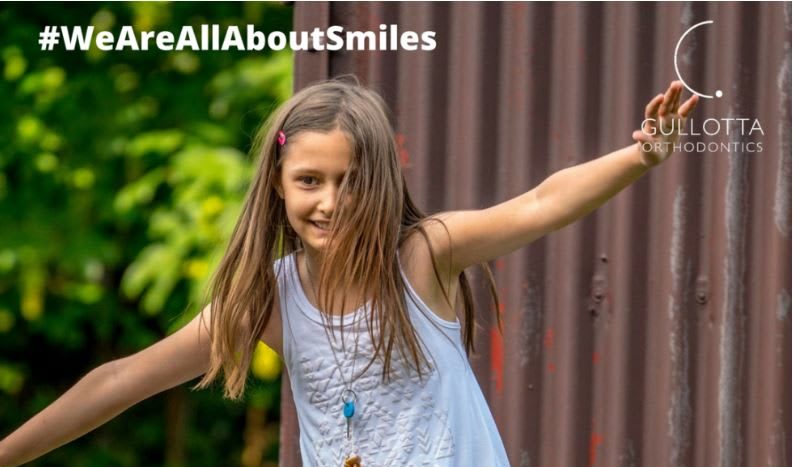As a Gold Coast Orthodontist with over 30 years’ orthodontic experience, Dr Nino Gullotta has journeyed with many children, teens and adults towards a brilliant smile.
As the cost of orthodontic treatment is not something to be sneezed about, many parents are under the assumption that it is not necessary for their child to first see an orthodontist before they are in their teens.
Nothing could be further from the truth. It is very important that if your child is going to need orthodontic treatment that they should first see an orthodontist around the age of 7 to 10 years as recommended by Orthodontics Australia (the Australian Society of Orthodontics public information and advice channel.) At this age, a child’s permanent teeth are coming in and their smile is starting to form.
When Should A Child Start Orthodontic Treatment
It is unlikely that your 7-year-old child will start orthodontic treatment straight away. However, this initial early orthodontic evaluation with Dr Nino Gullotta will allow him to determine the treatment your child will need and the best time to start so that it is most effective and of the shortest duration possible.
At this initial consultation, Dr Nino Gullotta will thoroughly examine your child’s jaw and teeth. X-rays will be taken and sometimes a 3d Video scan of your child’s upper and lower teeth.
Why Earlier Orthodontic Treatment is Better
As children have soft alveolar bones (supporting roots of the teeth) and soft facial bones orthodontic treatment can be quicker and thus less expensive. This is particularly true when treating a child for malocclusion (an out of alignment bite) which can distort a child’s face which can cause speech problems and also the aesthetics of the child’s face.
Also, early orthodontic treatment is very important if your child has a serious issue such as a poorly formed lower jaw. If treatment is left until after the bones have hardened it can be very difficult and in some cases even impossible to rectify this problem through orthodontic treatment and may require surgery.
Early orthodontic treatment is also better for your child’s well being as the treatment time is usually shorter and less pressure is required to correct crooked teeth, overcrowding etc. Also, if we are lucky, the treatment can be done before a child develops poor self-esteem caused by an unattractive smile.
Early orthodontic treatment is known as interceptive orthodontic treatment – and what this means is that an orthodontist can use a child’s natural growth to correct jaw and teeth issues and that this treatment can also mean that it prevents other more complex orthodontic treatment that would be required if interceptive orthodontic treatment was not done. Thus we cannot stress how important it is that your child first see an orthodontist when they are young and treatment plans can be made which will be of great benefit for your child.
Some Common And Not So Common Reasons Why Children Need Orthodontic Treatment
Thumb Sucking
If a child sucks his/her thumb past the age of 4 this can cause the top teeth to extend forward and protrude. A child’s bottom teeth may also be affected, most likely extending backwards. This impacts upon the child’s bite and they could have an open bite whereby the lower and upper teeth do not meet at the front, yet the back teeth do.
Thumb sucking can also affect the normal growth of a child’s jaw. Known as a crossbite, this occurs when a child’s upper jaw is too narrow for the lower jaw and can be a result of the overuse of the cheek muscles as a child thumb sucks.
There are ways that a parent can help stop a child from thumb sucking.
Missing Adult Teeth
As noted above, part of his initial consultation with you and your child, Dr Nino Gullotta will take an x-ray of your child’s teeth. This x-ray will reveal (amongst other things) whether your child will have a full set of adult teeth or if some adult teeth are missing, known as hypodontia.
Knowing that adult teeth are missing allows Dr Nino Gullotta to examine which of the different treatment options are going to be best for your child. One such option would be to use braces to create a wider gap where the missing tooth should appear so that a dental implant or bridge can be fitted at a later date. Another treatment option is the use (again) of clear or metal braces to extend the teeth evenly across the jaw so that the missing tooth (teeth) is not noticeable.
Crooked / Twisted Teeth
Crooked teeth come in all shapes and sizes. Not only can crooked or twisted teeth make a child self-conscious, but they are harder to keep clean as a toothbrush may not be able to reach unusual gaps caused by crooked teeth. Flossing too can be more difficult and with less than perfect dental hygiene a child with crooked or twisted teeth is going to be more susceptible to bacteria and this can lead to a build-up of plaque, to gum disease and cavities.
Overcrowding
Overcrowding occurs when there is not enough space in the child’s jaw to accommodate all their teeth. Braces can be used to straighten and correct overcrowded teeth if the overcrowding is not too severe. In some cases, treatment may include extracting one or more teeth and orthodontic treatment using braces. The length and type of treatment depend upon the severity of the condition and Dr Nino Gullotta will be able to advise you on this.
Tips for Parents with Children Adverse to Braces
Luckily in recent years, braces have almost become a fashion! The choice of different coloured bands has helped this along. Ceramic, clear brackets are also available which are much less noticeable than metal braces.
However, if you have a child who is reluctant to undergo orthodontic treatment, you can let them know that teenage heartthrob Justin Bieber had braces, and also both princes, Prince Harry and Prince William had braces on their bottom teeth to create their now famous smiles.
Also, a modern option to conventional braces is Invisalign clear aligners. These are a series of custom fitted clear removable “aligners” (that look like very thin mouthguards) that gently straighten teeth. Teens and pre-teens are now being treated with Invisalign
Finally, parents can help guide their children into understanding that the orthodontic treatment is for a fixed period of time, after which they will have a lifetime of smiles :) By giving your child something to look forward to, (a lifetime of a beautiful smile) orthodontic treatment can even be seen as fun and exciting!



